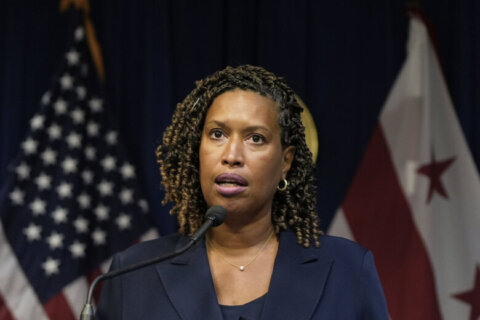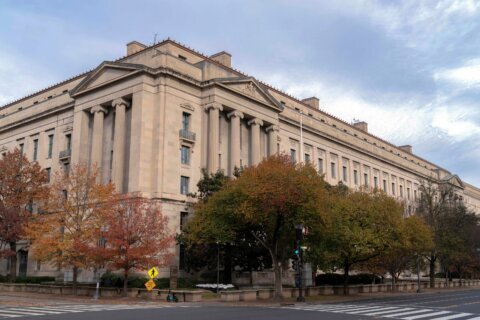Friday marks D.C.’s 159th Emancipation Day, a day which is taught as being the first step toward freeing enslaved Black people in the U.S. But the history and legacy surrounding Emancipation Day is not so simple.
An area history professor said emancipation in D.C. was one of the first big steps toward ending the institution of slavery in the United States, but the culture that upheld the institution of slavery remained ingrained in our country, and still is today.
“When you think about the legacy of emancipation, it’s a blip,” said Dr. Donald Earl Collins, lecturer of American history at American University. “It’s a blip in the struggle to deal with a country that has consistently seen Black folks as being less equal to whites.”
April 16, 1862
On April 16, 1862, President Abraham Lincoln signed the The D.C. Compensated Emancipation Act, which freed 2,989 enslaved Black women, men and children in D.C. during the Civil War.
Collins said there had been “clamoring in the capital itself to get rid of slavery as an institution” since about 1850.
The Compromise of 1850 was the first move in the U.S. toward ending slavery with the elimination of the domestic slave trade within D.C.
In the spring of 1862, the U.S. was in its second year of the Civil War between the U.S. and the seceded Southern states, primarily over the right to continue to enslave Black people.
During this time, Collins said, the D.C. area was covered with forts, cannons and Union soldiers who feared an invasion from the Confederacy.
He said Lincoln saw an opportunity to “kill two birds with one stone” by ending slavery in the District and making it a strategic place for a military standpoint. So on April 16, Lincoln signed D.C.’s Emancipation Act into law.
Collins said that out of the nearly 14,000 people of African descent living in the capital in 1862, most were already free. Only around 3,000 enslaved people were actually freed after the passage of the act.
“So it’s symbolic as well as it is a real freedom for those 3,000 or so enslaved Africans,” he said. “We can end this process. We can end this institution and move forward with our society for free Blacks.”
As word spread that D.C. had become a city for free Black people, Collins said, enslaved people began escaping from other parts of the country, specifically from Confederate states, to D.C. and began to settle down.
This nearly tripled D.C.’s population of Black people over the decade, “from about 14,000 total people who are of African descent living in D.C. in 1860 to about 43,000 by the end of the decade,” he said.
As of 2019 U.S. Census data, 46.3% of D.C.’s population identities as Black or African American, making up D.C.’s largest racial group.
“Lincoln’s strategy there was not short-term. It was long-term,” Collins said. “It was about the idea of being able to bring these people up here and possibly have them join the Union Army or provide work as part of the war effort to deprive the South of much needed labor.”
The fight to end slavery
Following Emancipation Day in D.C., three other major events led to the end of slavery in the U.S.: the Emancipation Proclamation of 1863, Juneteenth and the 13th Amendment.
The Emancipation Proclamation, signed by Lincoln, is widely regarded as what freed enslaved Black people and has led to Lincoln being referred to as the Great Emancipator.
However, Collins said, that’s not the reality: The Emancipation Proclamation indicates that if someone is an enslaved person in the Confederacy, in a state that is still fighting in the Civil War against the Union, they need to escape to a Northern state in order to be free.
“Those people weren’t technically free until they made it to free ground or the Union Army somehow got there and freed them formally,” Collins said. “So when people say the Emancipation Proclamation freed the slaves, no it didn’t. It didn’t free anybody.”
“As long as there’s no Union Army presence, the slave owners are not going to tell their slaves that, ‘Hey, you’re free now.'”
He said the passage of the 13th Amendment in December of 1865 is what formally ended chattel slavery in the U.S., but an enslaved person’s date of freedom depended on where they were in the U.S.
“You’re talking anywhere between D.C. in 1862, and Texas in June of 1865. In other parts of the country, maybe not until December of 1865.”
Life for formerly enslaved people
After the institution of slavery had been eradicated throughout the country, Collins said, Lincoln struggled with how to proceed with a society that now included nearly four million free Black people.
“He’s struggling about, ‘What do we do with these people? Do we send them back to Africa?’” he said. “As if these people all came from Africa like 20 years ago, when the fact is this institution has been around for 250 years. These people were born here.”
As a form of compensation in the D.C. Emancipation Act, former white enslavers who stayed loyal to the Union were paid up to $300 in D.C. for each freed enslaved person. In the same act, it offered $100 to each free Black person if they left the U.S.
Between 1862 and 1866, Collins said, there were no formal policies in place against free Black people, but “there certainly would have been customs that these folks would have had to adhere to in order to deal with the possibility of retaliation from whites.”
A free Black person wouldn’t generally mingle with white people. “That doesn’t mean that happened across the board. D.C. is an interesting place,” he said.
Collins said there was a period in the 1860s where white and Black people were going to the same churches before Black people built their own, but it didn’t last long.
Fewer than 10 years after Emancipation Day, D.C. passed the Organic Act of 1871, which Collins said formally segregated the city in 1874.
“So there’s that as sort of policy-related symbolism,” he said. “Here you are one of the first Southern sites to be fully rid of slavery, at the same time, ‘OK, let’s segregate folks.'”
Lasting legacy
Black D.C. residents have been celebrating Emancipation Day in the streets of D.C. with an annual parade since the end of slavery until 1901. The parade was brought back in 2002 and in 2004 the District made the day an official city holiday.
Normally, residents celebrate the day with a citywide parade, music and dancing, but due to COVID-19, the city is hosting a mix of virtual and in person celebrations that started at the beginning of April and go until the end of the day on April 16.
However, parades and celebrations aren’t the only remnants from this period of emancipation.
“D.C. has literally hundreds of hundreds of memorials and statues, and other sort of symbols from the Civil War. Some of those symbols are people who were on the side of the Confederacy, people we consider traitors,” Collins said.
He added that Arlington National Cemetery used to be a plantation that belonged to Robert E. Lee, commander of the Confederate Army.
Collins said the legacy of slavery made full-fledged membership in American society difficult even after the institution ended: “It’s really hard to be part of a country where your first 250 years as a large group has been around this issue of being owned by other human beings.”
He called Emancipation Day “a big step,” but only one step toward solving a larger institutional problem.
“They need to take the leap that Blacks were equally human to whites. They never got there,” he said.








